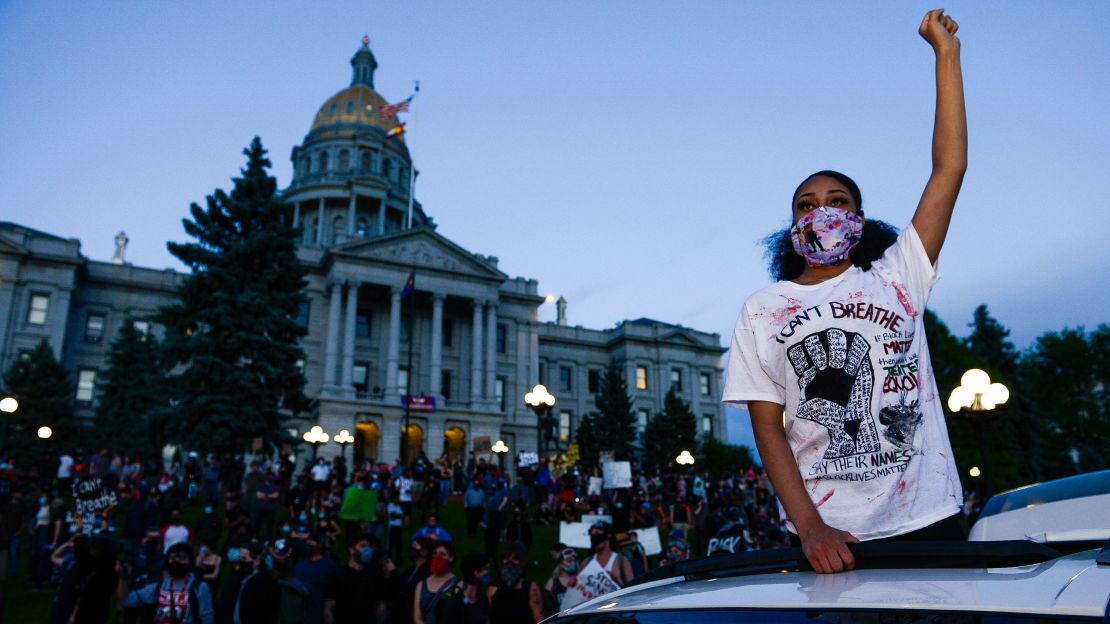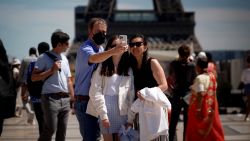A version of this story appeared in the May 30 edition of CNN’s Coronavirus: Fact vs. Fiction newsletter. Sign up here to receive the need-to-know headlines every weekday.
Anger and pain are stronger than fear.
Protests erupted overnight in at least 20 American cities, with large crowds demonstrating against police brutality despite the coronavirus threat.
US health officials have warned people to avoid mass gatherings as the number of confirmed Covid-19 cases keeps rising.
But the protests have gained momentum.
Rather than trying to halt them, officials like the mayors of New York City and Louisville, Kentucky, are urging people to protest with the virus in mind. And organizers of a New York City demonstration yesterday asked people to wear face coverings and practice social distancing.
These are not the first protests in the US during this pandemic. But, as Brandon Tensley writes, the scenes differ profoundly with protests last month, when armed, mostly white and maskless demonstrators entered the Michigan Capitol building during a rally against a stay-at-home order. In that case, police officers stood still.
The US isn’t the only country witnessing protests amid the pandemic. People are back on the streets in Hong Kong, rallying against China’s decision to impose a national security law on the territory. And prominent journalists in Russia were detained earlier this week while protesting the arrest of a colleague.

YOU ASKED. WE ANSWERED
Q: Which age groups get infected the most? And what’s the breakdown of coronavirus deaths by age?
A: Adults between ages 18 and 44 have the highest number of infections, according to data from the US Centers for Disease Control and Prevention. As of late May:
- 4% of patients with coronavirus in the US were younger than 17
- 39% were 18 to 44 years old
- 35% were 45 to 64 years old
- 10% were 65 to 74 years old
- 12% were 75+ years old
While a large number of young adults have been hospitalized with coronavirus, and scores have died, a majority of deaths occur among seniors. Of those who died:
- 0% were 0 to 17 years old
- 2.7% were 18 to 44 years old
- 17.6% were 45 to 64 years old
- 21.3% were 65 to 74 years old
- 58.4% were 75+ years old
But it’s important to note there may be a lag between when deaths happen and when they are reflected in the CDC’s count – the tally above may be incomplete.
Send your questions here. Are you a health care worker fighting Covid-19? Message us on WhatsApp about the challenges you’re facing: +1 347-322-0415.
WHAT’S IMPORTANT TODAY
How Vietnam keeps its death count at zero
The country of 97 million people has not reported a single coronavirus-related death, despite its long border with China.
So how has Vietnam, with its lower middle-income economy and underdeveloped healthcare system, escaped the scourge of the coronavirus? The answer, Nectar Gan reports, lies in several factors: from the government’s swift response to prevent its spread, to rigorous contact-tracing, quarantining and effective public communication.
US quits the WHO
President Donald Trump announced yesterday that the US will cut ties with the World Health Organization, a move he has threatened throughout the coronavirus pandemic. Trump has accused the health agency of failing to hold China accountable for the spread of the virus.
The move isolates the US on the world stage during the global crisis. And groups representing infectious disease doctors, pediatricians and general physicians have protested the decision.
Covid-19 is much deadlier for diabetics
One in 10 coronavirus patients with diabetes died within the first seven days of hospitalization, according to a study by French researchers, and one in five needed a ventilator to breathe. Most – 89% – had Type 2 diabetes; 3% had Type 1 diabetes; and the rest had other forms of the disease.
Health experts believe diabetes represents an underlying health condition that places people at greater risk of developing Covid-19. The study seems to confirm this.
New epicenter could be the worst yet
Latin America is reporting more daily coronavirus cases than the United States.
In some of the region’s biggest countries, politics have informed the response to the virus – with ideology appearing to have trumped best medical practices.
Numerous experts say faulty government responses, coupled with the region’s frail economies and public health systems, have worsened the severity of the outbreak. And they have a stark warning: things are likely to get worse.
Pangolins may have incubated the virus
A deep dive into the genetics of the novel coronavirus shows it may have spent time infecting bats and pangolins before humans, researchers said yesterday. Up to a third of the pangolin species may have played host to the virus. But researchers say it’s too soon to blame pangolins for the pandemic.
ON OUR RADAR
- Remember the crowded “Zero Ducks Given” Memorial Day weekend party in the Lake of the Ozarks, Missouri? One of its attendees has tested positive for coronavirus – and was possibly infectious over the holiday weekend.
- With the exception of the days Boris Johnson spent in intensive care, this past week has been his worst since taking office. The Prime Minister is embroiled in a scandal involving his chief adviser, Dominic Cummings, who has travelled across the country during a lockdown. Luke McGee reports.
- President Trump called Democratic North Carolina Governor Roy Cooper on Friday and insisted he host a Republican convention this summer with no face masks or social distancing, according to the governor’s spokesperson .
- Inseparable twin sisters have started nursing careers together at the same hospital.
- A troop of monkeys snatched the blood samples of suspected coronavirus patients at a government hospital in the north Indian state of Uttar Pradesh.
- Drive-in concerts may be the answer to the summer shows you’re missing.
- You can still escape to San Francisco (from home).
TOP TIPS
Need a plumber or babysitter to come to your home? Here’s how to keep everyone safe.
Expect more personal protective equipment and social distancing — clients may be asked to wear masks too.
Be transparent: both parties will have to be honest with each other about their health status before the scheduled date of service.
Set the rules that you are most comfortable with, such as mask wearing and frequent hand washing. But remember this is not a one-sided discussion. The caregiver’s health is on the line, too.





















